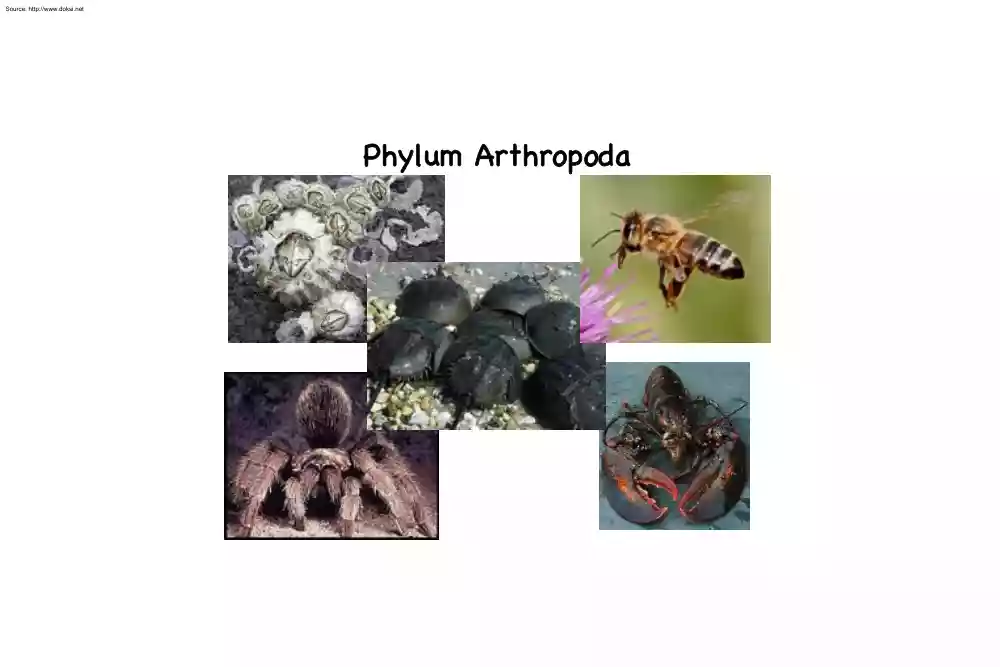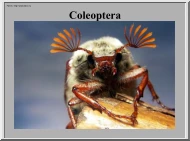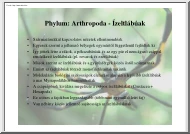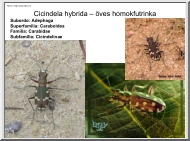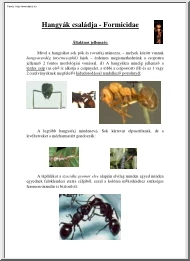Datasheet
Year, pagecount:2010, 24 page(s)
Language:English
Downloads:6
Uploaded:November 13, 2017
Size:1 MB
Institution:
-
Comments:
Attachment:-
Download in PDF:Please log in!
Comments
No comments yet. You can be the first!Most popular documents in this category
Content extract
Source: http://www.doksinet Phylum Arthropoda Source: http://www.doksinet Arthropod Characteristic = “jointed limbs” Segmented body = metamerism = grouped into 2/3 regions Paired segmented appendages Chitinous exoskeleton Tubular alimentary canal Coelom reduced to hemocoel Open circulatory system Respiration by gills, tracheae or spiracles Anterior ganglion, paired connectives & nerve cords Malphigian tubes = excretion Separate sexes Source: http://www.doksinet Arthropod Fun Facts You are here! Aphids are born pregnant No two spider webs are alike Adult bed bugs can survive 1 year without food Hornet sting has highest concentration of AChE Bed houses 6 billion dust mites Ant queen can live 15 years Dragon flies can reach 60 MPH Each year insects eat 1/3 earth’s food crop Citronella irritates mosquito feet Mosqitos prefer children to adults, blondes to brunettes Source: http://www.doksinet Arthropod Fun Facts Lobster blood = blue, insect = yellow Flea leap =
greater acceleration than space shuttle Black widow venom more powerful than rattlesnake Parasitic wasp = smaller than housefly eye More insects in 1 mile2 than humans on earth Honeybee kills more people than poisonous snakes Among the deadliest insects are kissing bugs and African ants Source: http://www.doksinet Arthropod Generalized Bauplan 1. Longitudinal view Three distinct sections or tagmata: head, thorax and abdomen (different classes have slightly different names) Head = antennae, mouthparts, tightly fused = cranium = difficult to determine # of segments involved Thorax = locomotor part of the body, three segments (often fused) Abdomen = may or may not contain appendages Source: http://www.doksinet Arthropod Generalized Bauplan 2. Appendages Lack ciliation for movement = even during larval stages Problem = rigid exoskeleton Solution = appendages of plates and cylinders Skeleton + muscles = leverage Adapted for different functions on types of locomotion Uni- or biramous
Source: http://www.doksinet Arthropod Generalized Bauplan 3. Cross section Loss of coelom associated with open circulatory system Hemocoel = internal organ are bathed in body fluids Body size demands pumping organ Cephalization, ganglions due to metamerism Source: http://www.doksinet Arthropod Generalized Bauplan 4. Exoskeleton = secreted by epidermal cells Epicuticle = outermost, hard protein cross link, waxy lipoprotein (cement layer, waxy layer and cuticulin) Procuticle = bulk of exoskeleton, made of exo-and endocuticle, flexible, composed largely of chitin, strengthened by calcium Source: http://www.doksinet Moulting or Ecdysis Involvement ecdysone (hormone) a) Old skeleton detached from epidermis b) Epidermis secretes epicuticle c) Enzymes degrade exoskeleton d) Secretion of new procuticle e) Old skeleton splits f) Extrication from old skeleton g) “Sclerotinization” = tanning h) Some animals consume old skeleton Source: http://www.doksinet Generalized Bauplan
Differentiation Source: http://www.doksinet Subphylum Cheliceriformes Source: http://www.doksinet Cheliceriformes Characteristics 65,000 described species Some paleozoic forms were 2 m length Rich fossil record Most species live on land Mites secondarily inhabited aquatic habitats Body composed of: Prosoma = cephalothorax (6 segments) Opisthosoma = abdomen (12 segments) ! bearing telson Book lungs or gills Source: http://www.doksinet Cheliceriformes Characteristics Appendages: chelicerae, pedipalps, walking legs = multiarticulate/uniramous Excretion by coxal glands/ Malphigian tubules Simple medial eyes, sometimes compund eyes Most gonochoristic/ dioecious Source: http://www.doksinet Class Chelicerata Source: http://www.doksinet Subclass Merostomata Preserved specimen of Limulus polyphemus 1. Carapace 2. Telson 3. Compound eye 4. Anterior spine Called horsefoot by Thomas Hariot Harmless and non poisonous Telson used as lever or rudder Asian horseshoe crabs = delicacy (up
to $50/animal, American horseshoe crabs = bait ($1-2/animal) Source: http://www.doksinet 1 2 3 1. Chelicera 2. Pedipalps 3. Walking legs 4. Chilaria Source: http://www.doksinet Ventral view of abdomen of Limulus. 1. Genital operculum (covering genital pores) 2. Gill opercula (covering book gills) 3. Carapace 5. 4th chelate walking leg Source: http://www.doksinet Hemolymph = analogous to human blood Oxygen carrying protein = hemocyanin Breeding grounds = Delaware Bay Whelk fishermen use 20-25,000 horseshoe crabs annually as bait Source: http://www.doksinet Subclass Arachnida Carapace-like shield Opisthosoma appendages modified = spinnerets/pectines Book lungs Almost all terrestrial Over 60,000 species Carnivorous Eyes and tactile hairs Source: http://www.doksinet 1. Eyes 2. Chelicerae with fangs 3. Pedipalps 1 Spinnerets 2 3 Source: http://www.doksinet The “Joy” of Spider Reproduction Gonochoristic Sexual dimorphism Intricate mating duels (other males)
Courtship Sperm deposited in web Fertilized eggs in silk cocoon Source: http://www.doksinet Spider Art Source: http://www.doksinet Class Pycnogonida = sea spiders 600 species Carnivores Dt extends into legs Cold water Source: http://www.doksinet
greater acceleration than space shuttle Black widow venom more powerful than rattlesnake Parasitic wasp = smaller than housefly eye More insects in 1 mile2 than humans on earth Honeybee kills more people than poisonous snakes Among the deadliest insects are kissing bugs and African ants Source: http://www.doksinet Arthropod Generalized Bauplan 1. Longitudinal view Three distinct sections or tagmata: head, thorax and abdomen (different classes have slightly different names) Head = antennae, mouthparts, tightly fused = cranium = difficult to determine # of segments involved Thorax = locomotor part of the body, three segments (often fused) Abdomen = may or may not contain appendages Source: http://www.doksinet Arthropod Generalized Bauplan 2. Appendages Lack ciliation for movement = even during larval stages Problem = rigid exoskeleton Solution = appendages of plates and cylinders Skeleton + muscles = leverage Adapted for different functions on types of locomotion Uni- or biramous
Source: http://www.doksinet Arthropod Generalized Bauplan 3. Cross section Loss of coelom associated with open circulatory system Hemocoel = internal organ are bathed in body fluids Body size demands pumping organ Cephalization, ganglions due to metamerism Source: http://www.doksinet Arthropod Generalized Bauplan 4. Exoskeleton = secreted by epidermal cells Epicuticle = outermost, hard protein cross link, waxy lipoprotein (cement layer, waxy layer and cuticulin) Procuticle = bulk of exoskeleton, made of exo-and endocuticle, flexible, composed largely of chitin, strengthened by calcium Source: http://www.doksinet Moulting or Ecdysis Involvement ecdysone (hormone) a) Old skeleton detached from epidermis b) Epidermis secretes epicuticle c) Enzymes degrade exoskeleton d) Secretion of new procuticle e) Old skeleton splits f) Extrication from old skeleton g) “Sclerotinization” = tanning h) Some animals consume old skeleton Source: http://www.doksinet Generalized Bauplan
Differentiation Source: http://www.doksinet Subphylum Cheliceriformes Source: http://www.doksinet Cheliceriformes Characteristics 65,000 described species Some paleozoic forms were 2 m length Rich fossil record Most species live on land Mites secondarily inhabited aquatic habitats Body composed of: Prosoma = cephalothorax (6 segments) Opisthosoma = abdomen (12 segments) ! bearing telson Book lungs or gills Source: http://www.doksinet Cheliceriformes Characteristics Appendages: chelicerae, pedipalps, walking legs = multiarticulate/uniramous Excretion by coxal glands/ Malphigian tubules Simple medial eyes, sometimes compund eyes Most gonochoristic/ dioecious Source: http://www.doksinet Class Chelicerata Source: http://www.doksinet Subclass Merostomata Preserved specimen of Limulus polyphemus 1. Carapace 2. Telson 3. Compound eye 4. Anterior spine Called horsefoot by Thomas Hariot Harmless and non poisonous Telson used as lever or rudder Asian horseshoe crabs = delicacy (up
to $50/animal, American horseshoe crabs = bait ($1-2/animal) Source: http://www.doksinet 1 2 3 1. Chelicera 2. Pedipalps 3. Walking legs 4. Chilaria Source: http://www.doksinet Ventral view of abdomen of Limulus. 1. Genital operculum (covering genital pores) 2. Gill opercula (covering book gills) 3. Carapace 5. 4th chelate walking leg Source: http://www.doksinet Hemolymph = analogous to human blood Oxygen carrying protein = hemocyanin Breeding grounds = Delaware Bay Whelk fishermen use 20-25,000 horseshoe crabs annually as bait Source: http://www.doksinet Subclass Arachnida Carapace-like shield Opisthosoma appendages modified = spinnerets/pectines Book lungs Almost all terrestrial Over 60,000 species Carnivorous Eyes and tactile hairs Source: http://www.doksinet 1. Eyes 2. Chelicerae with fangs 3. Pedipalps 1 Spinnerets 2 3 Source: http://www.doksinet The “Joy” of Spider Reproduction Gonochoristic Sexual dimorphism Intricate mating duels (other males)
Courtship Sperm deposited in web Fertilized eggs in silk cocoon Source: http://www.doksinet Spider Art Source: http://www.doksinet Class Pycnogonida = sea spiders 600 species Carnivores Dt extends into legs Cold water Source: http://www.doksinet
